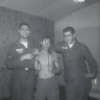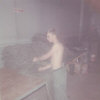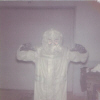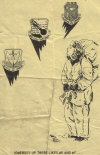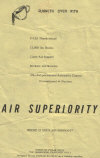Gerstle River Test Site
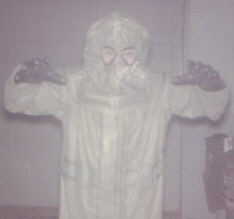
Butyl-rubber
outfit and
M9A1 gas mask in 1964
Photo: Jerrel Cook
OCTOBER 2002 - Following the declassification of secret US military documents during October 2002, it appears that troops of the "15th Artillery Battalion" were test subjects in the "ELK HUNT" chemical warfare tests during the 1960's.
Documents indicate that troops from the 15th, as well as other military units, were exposed to VX nerve gas at the Gerstle River Test Site (GRTS) near Fort Greely, Alaska.
ELK HUNT Phase 1 and 2 were both conducted near Fort Greely during 1964 and 1965. ELK HUNT Phase 1 was designed to determine the amount of VX nerve agent picked up on the clothing of personnel traversing various types of contaminated terrain. VX was disseminated from M23 mines detonated underground in three types of terrain and underwater.
ELK HUNT Phase 2 was similar but added vehicles traversing the contaminated terrain. It has been reported that Canadians conducted 5 of 35 trials.
ARMY
TIMES ARTICLE:
http://www.armytimes.com/print.php?f=0-213079-1048825.php
US ARMY CORPS OF ENGINEERS MAP

VX
Nerve Gas Tests
Posted: October 9, 2002
Elk Hunt, Phase II tests conducted by the Deseret Test Center were designed to determine the amount of VX nerve agent exposure to military personnel. Thirty-five trials were conducted near Fort Greely, Alaska between June 7 and July 27, 1965. Eleven additional vehicle decontamination trials were conducted from October 27 to December 17, 1965. Personnel who participated in Elk Hunt, Phase II wore complete, impermeable butyl-rubber outfits and M9A1 gas masks.
In 1955, these compounds were designated V-series agents for “venomous.” VX nerve agent is from the organophosphate group that acts as a cholinesterase inhibitor, and is one of the most toxic substances ever synthesized.
Units Involved: Selected personnel assigned to HHC, 171st Infantry Brigade, 15th Artillery Battalion, 40th Armor Battalion, 4th Battalion, 9th Infantry, 1st Battalion, 47th Infantry, 538th Ordnance Company (Direct Support).
Other tests: 20 tests between July 3 - August 15, 1964 at Fort Greely. Plus more in other areas 1962-1973.
Photos
submitted by Jerrel Cook
Formerly of HHC, 171st
INF BDE
Jerrel
Cook was a member of 171st Infantry Brigade in Alaska and participated
in the ELK HUNT tests. Veterans he served with report a high incidence of cancer and thyroid
problems. He has provided
the following photos and news article from his tour in Alaska.
The Wild Bunch
at Gerstle River
1964
Jerrel Cook
folding
rubber suits at
Gerstle River, AK
Full rubber suit
protective gear
Gerstle River 1964
Roy Harwood with
Gerstle River in the
background
More photos of
Alaska
Photo
credits: Jerrel Cook
HHC, 171st
INF BDE
Frozen
Alaskan
terrain
Yukon Command
Library card
Psywar
flyers indicating US air superiority
10,000
Troops Prepare
For Exercise Polar Siege
Exercise POLAR SIEGE , Alaska's 1964 winter combat test, will engage
more than 10,000 soldiers and airmen., Alaskan Command planners have
announced. According to Lt Gen Raymond J. Reeves, Commander-in-Chief,
Alaska, it will be the largest combined military exercise ever held in
Alaska in terms of men involved. The 12-day series of simulated battle
maneuvers will begin January 30th.
POLAR SIEGE will be an Alaskan Command exercise
testing the nation's ability to organize custom built fighting units and
to conduct operations in the under-developed northern latitudes.
4000 Airlifted
About 4,000 of the troops for the exercise will be airlifted to Alaska
from other states and Canada. The remainder will be from the Army, Air
Force and National Guard units already in Alaska.
POLAR SIEGE will be staged over a huge strip of
wilderness in central Alaska. One of the coldest areas in North America,
it is a rugged, undeveloped region of some 2,400 square miles.
"Good Guys"
Soldiers of the 4th Infantry Division, Fort Lewis, Washington, who are
playing the role of "Good Guys" in the exercise will be well
equipped when the exercise gets underway, according to Lieutenant
Colonel Gordon W. Bailey, who is in charge of an advance party now on
Fort Richardson.
"Our job is to draw and purchase
equipment," explained Colonel Bailey, a native of Cincinnati, Ohio,
"then convoy it up to our base camp and prepare the site for the
main body of troops."
In a crowded headquarters office at Fort Richardson,
Colonel Bailey and his staff are co-ordinating the efforts of nearly 800
Fort Lewis soldiers who are members of the advance party.
A Big Moving Job
They'll
have a big moving job -- the 4th Division's equipment must be trucked
more than 300 miles over ice-slickened highways to the base camp at
Eielson Air Force Base near Fairbanks, on the edge of the
2100-square-mile exercise area in central Alaska.
"Our party staged in at Fort Richardson January
6-7," said Colonel Bailey. "We were brought up from McChord
Air Force Base (near Tacoma, Wash.) by the 62nd Troop Carrier Squadron.
"We'll have to have everything ready at Eielson
by January 16, when the Air Force will start bringing in the main body
of troops."
The troops whose way Colonel Bailey is paving will
form the nucleus of the Friendly Forces during the 12-day test, which
starts January 30. They will face an Aggressor force composed of the
171st Infantry Brigade (Mechanized) from Fort Wainwright, Alaska.
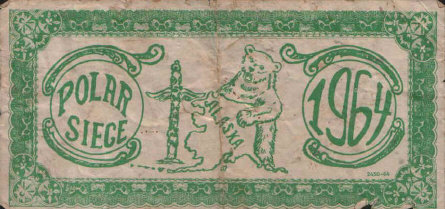
Image credits: Jerrel Cook
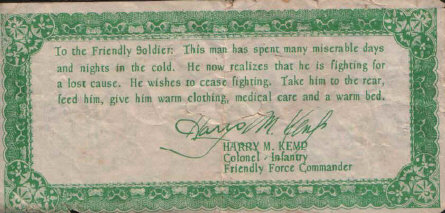
= Declassified 2002 =
DEPARTMENT
OF THE ARMY
OFFICE
OF THE PROJECT MANAGER FOR CHEMICAL DEMILITARIZATION AND INSTALLATION
RESTORATION ABERDEEN PROVING GROUND, MARYLAND
December 1976
EXECUTIVE SUMMARY
During August 1976, a Records Research study was conducted at Fort Greely to estimate possible contamination at the Gerstle River Test Site by chemical, biological, and radiological material, and to assess the possibility of contaminants migrating beyond the boundaries of the installation. As a result of the records search survey, it was discovered that the same organization, which conducted the chemical agent tests at the Gerstle River area, also conducted biological agent tests at the Delta Creek area of Fort Greely, Alaska.
Those in charge of this project were Captain James Verney and Captain David Moss of the U.S.A. Cold Regions Test Center. They served as points of contact for the assessment. Also, Mr. Bert Johns of Dugway Proving Ground was in charge of test operations for Dessert Test Center from 1962 to 1967. He possessed intimate knowledge of test and surveillance operations conducted at the Gerstle River Test Site during this period. There were only five copies of this official report that were to be disseminated to the Commander of the U.S. Army Cold Regions Test Center, Ft. Greely and Office of the Project Manager for Chemical Demilitarization and Installation Restoration, Aberdeen Proving Ground, Maryland. The American Gulf War Veterans Association is grateful to an unknown concerned citizen who provided these documents anonymously.
Summary Description of Ft. Greely, Alaska and U.S. Army Cold Regions Test Center (CRTC)
Ft.
Greely contains 661,814 acres and lies in the southeastern portion of
interior Alaska known as the Tanana Lowlands. Its location if 64 degrees
North latitude and 145 degrees, 43 minutes West longitude. The city in
closest proximity is Delta Junction, which is five miles north. The
nearest city of major population is Fairbanks, which is 100 miles to the
northwest. The Alaska Highway and the Richardson Highway pass Fort
Greely and join at Delta Junction. At the time of the Gerstle River
Project (1962-1974), the U.S. Army Cold Region Test Center was a tenant
activity at Fort Greely and had operational control. Quoting from the
report: "The Delta Creek area, adjacent to the USAF bombing range,
was used for biological agent testing from 1963 through 1967."
HISTORY
Fort Greely, Alaska Wing, Air Transport Command, Big Delta, Alaska, was first occupied by Army Troops in 1942. It served as a staging area for aircraft being ferried to Russia under the lend-lease agreement. It was later designated as the Army Arctic Training Center and in 1953 a permanent post was constructed. In 1964, the U.S Arctic Test Board was re-designated the U.S. Army Arctic Test Center. During 1966, the General Equipment Test Branch, which was located at Fort Wainwright, was absorbed by the Nuclear Biological, Chemical and Special Projects Division at Fort Greely. In 1976, the U.S. Army Arctic Test Center was re-designated the U.S. Army Cold Regions Test Center.
The Gerstle River Test Site, which parallels the Alaska Highway was acquired by the U.S. Army in 1952 for an indefinite period and was used by Dugway Proving Ground for chemical and high explosive testing from 1954 to 1962. In 1954, Dugway Proving Ground (DPG) initiated a comprehensive program for the surveillance testing of chemical and biological materials. From 1954 to 1962, a comprehensive Arctic Environmental/Surveillance Program on Chemical Corps material was conducted at the Gerstle River Test Site (GRTS). Limited cold weather dissemination testing of GB (sarin gas and VX, deadly nerve agents) was conducted in this area. (Note: President Clinton recently bombed a pharmaceutical plant in Sudan that he stated was producing precursor of VX --this has now been proven to have been false as the plant was truly a pharmaceutical production facility.) It is indeed startling to find out that our own country was, in fact, testing these deadly nerve agents within five miles of the inhabitants of Delta Junction, Alaska. Single round, GB-filled (Sarin) munitions were tested in the winters of 1955 through 1957. Six trials of VX-filled M23 mines were conducted in the winter of 1960-61. The majority of testing at the Gerstle River Army Test Site was with single round, statically fired, chemical munitions. However, GB filled 155mm howitzer shells were dynamically fired into spruce forests.
Sarin Gas, VX nerve agent, high explosives, (including mines, projectiles and rockets) as well as BLU 19/B23 bombs and bomblets, M23 Land Mines, M55 Rockets, 155mm Howitzers, and M121A-1 shells, were tested under the Codenames of: Whistle Down, Elk Hunt, Devil Hole, Swamp Oak, Sundown and Dew Point.

LINKS:
MSDS Sheet on "Lethal Nerve Gas - VX"
Ft. Greely Nuclear Reactor report
Gerstle River Installation Assessment
US Army Corps of Engineers - Alaska
Four page report in ADOBE
format:
http://deploymentlink.osd.mil/pdfs/elk_hunt_ii.pdfFor more information:
1-800-497-6261 or 1-703-578-8500

